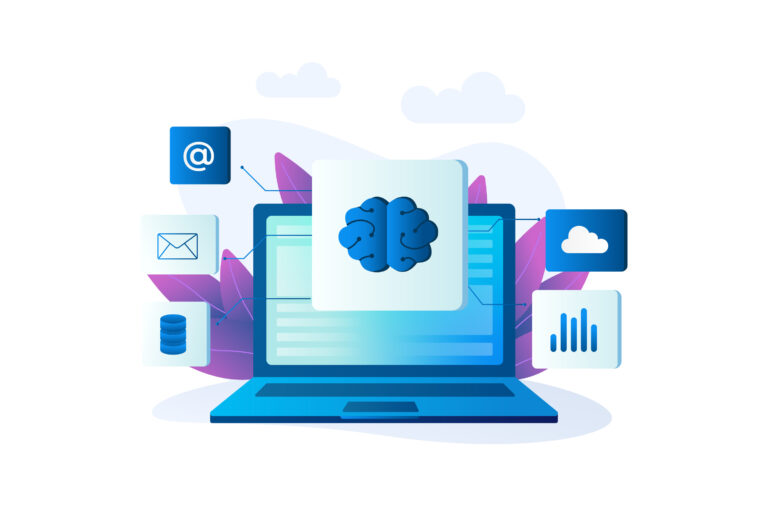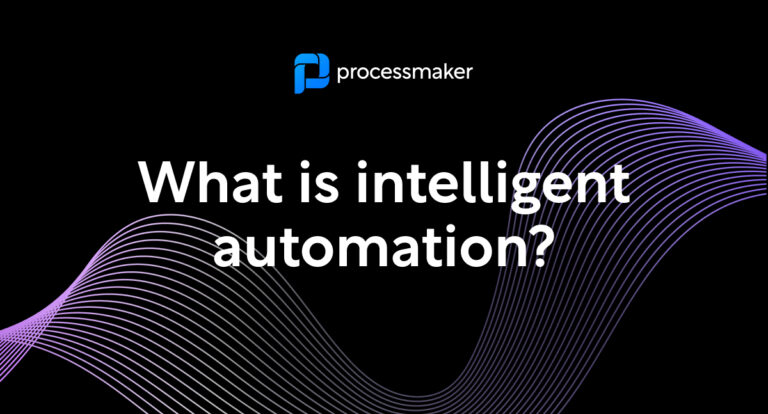Qu'est-ce que l'intelligence du contenu ? Décortiquons-le.
L'intelligence de contenu utilise le traitement intelligent des documents, l'apprentissage automatique et l'IA pour aider les travailleurs du savoir à trouver les connaissances dont ils ont besoin pour accomplir leurs tâches.
Une stratégie d'intelligence du contenu bien huilée permet de retirer les couches de documents importants pour révéler des informations que vous n'auriez pas pu obtenir autrement. Et ce type de contenu n'est pas toujours facile à trouver.
Combien de fois vous est-il arrivé de vous remémorer une anecdote intéressante partagée lors d'une présentation, avant d'oublier l'endroit où vous l'aviez vue ?
Par exemple, un membre du service marketing présente un rapport convaincant sur les comportements des clients. Le rapport contient des pages de révélations sur les concurrents du marché, les préférences des clients et les habitudes d'utilisation des produits. Mais s'il est impossible pour un employé du service des ventes ou du développement de produits de le localiser, l'idée gagnante finit par se perdre dans les méandres de l'entreprise. L'idée gagnante se perd finalement dans les méandres de l'intranet de l'entreprise.

La question "Où ai-je vu ça?" déclenche une recherche qui dure des heures et qui, selon McKinsey, gaspille 19 % de la semaine de travail. En l'absence d'une stratégie d'intelligence du contenu, l'instant "a-ha" qui aurait pu propulser votre entreprise vers de nouveaux sommets disparaît aussi vite qu'un nuage.
Essai gratuit : Créer un processus en quelques secondes
Heureusement, pour de nombreuses organisations, la meilleure solution se trouve juste sous leur nez, dans des données existantes qui sont tout simplement trop difficiles à trouver. L'intelligence du contenu consiste à exploiter les connaissances inexploitées que vous avez déjà sous la main. Voici comment procéder :
Un moteur de recherche pour les connaissances organisationnelles
La façon dont votre organisation gère les documents et les données est au cœur de l'intelligence du contenu. En l'occurrence, les données non structurées.
Même si vous passez plusieurs heures par jour à travailler sur des feuilles de calcul, c'est la partie la plus facile. Les données non structurées comprennent les messages Slack, les Google Docs, les PDF, les échanges sur les médias sociaux et les PowerPoint de la réunion de vente du dernier trimestre. Il s'agit de tout le contenu libre qui ne suit pas un modèle prévisible comme les lignes et les colonnes.
C'est pourquoi les données non structurées sont beaucoup plus difficiles à analyser. Pour améliorer la "trouvabilité", nous avions l'habitude de nous appuyer sur une structure de fichier ou une taxonomie stricte. Mais les étiquettes qui s'appliquent à un département peuvent ne pas impliquer la raison pour laquelle un autre département a besoin de l'information. Cela peut être un problème pour la plupart des organisations, étant donné que 80 à 90 % des données ne sont pas structurées.
Le traitement intelligent des documents (IDP) met au premier plan les informations tirées du contenu non structuré. Vous n'avez plus besoin d'un métabalisage complexe pour tenter de gérer et de partager l'information. L'apprentissage automatique et l'intelligence artificielle s'associent pour ingérer, indexer et organiser votre contenu afin que vous puissiez y effectuer des recherches comme s'il s'agissait de votre propre Google.
Vous pourrez explorer les documents et donner vie à leur contenu au-delà de leur format d'origine. Grâce au traitement intelligent des documents, vous pouvez poser des questions sur les connaissances de votre organisation et obtenir une réponse, quel que soit l'endroit où elles se trouvent :
- Quel a été le produit le plus vendu en décembre 2021 ? (D'après les
rapports de vente) - Quel est le pourcentage de nos clients qui préfèrent les options en libre-service ? (Extrait d'une présentation marketing)
- Qui a été le représentant commercial du Sud-Est en 2018 ? (Extrait d'un document RH)

L'intelligence du contenu implique également des informations externes. Les organisations peuvent compiler presque tous les points de données qui passent par leurs processus. Pensez à ce que l'analyse des données par l'intelligence artificielle pourrait vous aider à trouver dans ce qui suit :
- Discussions sur Messenger ou WhatsApp
- Commentaires des clients sur Amazon, G2 ou Twitter (en fonction de votre secteur d'activité)
- Appels vocaux
- Échanges de courriels
- Capteurs IoT
- Habitudes d'utilisation de logiciels ou d'applications
Donner un sens aux données non structurées est un fléau de longue date pour les entreprises. Une étude réalisée en 2011 a révélé que 52 % des chefs d'entreprise déclaraient que les employés ne pouvaient jamais trouver des informations importantes dans un délai approprié. Douze ans plus tard, le problème persiste dans les entreprises qui ignorent l'automatisation des documents basée sur l'IA. Mais avec la mise en place d'un PDI, vous pouvez augmenter la productivité de la collecte d'informations de 25 à 35 %. Cela représente trois heures supplémentaires par employé et par semaine !
Essai gratuit : Découvrez comment automatiser la vérification d'identité
Intelligence du contenu et automatisation des processus
Le traitement intelligent des documents s'inscrit dans le cadre de l'automatisation des processus. Différentes tâches dans des processus tels que l'assistance à la clientèle, l'accueil des employés ou l'ouverture d'un nouveau compte collectent des informations. Ces informations peuvent provenir d'un document manuscrit, d'un PDF téléchargé ou d'un formulaire numérique rempli.
Avec une tâche de processus alimentée par l'IDP, vous pouvez extraire les informations nécessaires afin qu'elles soient prêtes à être utilisées dans d'autres domaines de votre organisation. L'intelligence artificielle et l'apprentissage automatique lisent les documents afin qu'ils soient plus faciles à trouver et à exploiter.
Comment l'intelligence du contenu améliore la portée du marketing
L'intelligence du contenu est aussi un moteur d'études de marché. D'un point de vue marketing, l'intelligence du contenu prend une nouvelle définition, mais elle reste sous-tendue par une meilleure gestion de vos données grâce à un traitement intelligent des documents.
Avec les bonnes données qui alimentent la prise de décision, vous pouvez améliorer la création de contenu et le ciblage des campagnes. Imaginez des profils d'utilisateurs enrichis de données provenant de l'ensemble de votre entreprise : comportements, ouvertures d'e-mails, données de vente, visionnages de vidéos... En fait, tout est possible.

L'intelligence artificielle peut vous aider à relier des contenus que vous auriez auparavant jugés sans rapport. À partir de là, vous pouvez activer les outils de marketing par l'IA :
- Découvrez quelles sont les fonctionnalités les plus appréciées des clients, celles qui doivent être améliorées et celles qui peuvent être supprimées.
- La génération de langage naturel, technologie qui entraîne les ordinateurs à imiter le langage humain, permet de créer des appels à l'action convaincants pour chaque utilisateur.
- Éliminez les conjectures et identifiez les sujets de vidéos, d'infographies ou de blogs qui intéresseront le plus vos clients.
S'appuyer sur des méthodes dépassées pour l'organisation des données prive les nouvelles stratégies de marketing d'informations essentielles. Avec l'intelligence du contenu, vous pouvez aller bien au-delà des indicateurs de vanité. L'intelligence artificielle ouvre de nouvelles portes à la création de contenu, mais seulement si vos données sont prêtes à être traitées.
Essai gratuit : Découvrez les solutions de traitement des factures
Les entreprises nagent dans des milliards de documents et de points de données qui représentent plus d'étoiles qu'il n'y en a dans le ciel nocturne. Désorganisés et chaotiques, ils ne forment pas de modèles, mais une soupe désordonnée d'étoiles dont il est impossible de tirer un sens.
L'automatisation intelligente des documents transforme votre contenu en une constellation discernable, alimentant ainsi l'intelligence du contenu d'aujourd'hui. Une fois la machine IDP en marche, les informations se répercutent dans d'autres domaines - marketing, ventes et ressources humaines. Avec une image plus claire de l'intelligence du contenu, vous pouvez donner un sens aux données d'une nouvelle manière, en découvrant de nouvelles connexions qui dépassent vos objectifs commerciaux.
Discutez avec notre équipe de la manière dont votre organisation peut tirer parti de l'intelligence du contenu.





